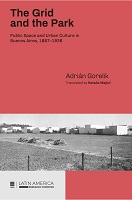The Grid and the Park
Public Space and Urban Culture in Buenos Aires, 1887–1936.
Author(s)
Gorelik, Adrián
Contributor(s)
Majluf, Natalia (other)
Language
EnglishAbstract
Since its publication in Spanish in 1998, The Grid and the Park not only revitalized studies on the history of Buenos Aires, but also laid the foundation for a specific type of cultural work on the city —an urban perspective for cultural history, as its author would describe it— that has had a sustained impact in Latin America. Public space, embodied in the grid of city blocks and the park system, here appears as a particularly productive category because it encompasses dimensions of the material city, politics, and culture, which are usually studied separately. From Domingo Faustino Sarmiento’s figurations of Palermo Park in the mid-nineteenth century to Jorge Luis Borges’s discovery of the suburb in the 1920s; from the modernization of the traditional center carried out by Mayor Torcuato de Alvear in the 1880s to the questioning of that centrality by the emergence of the suburban barrio, the book weaves the changing ideas on public space with urban culture to produce a new history of the metropolitan expansion of Buenos Aires, one of the most extensive and dynamic urban centers of the early twentieth century.
Keywords
Public Space; Late 19th and Early 20th centuries; Buenos Aires; Cultural History; Urban HistoryDOI
10.25154/book8ISBN
9781951634209, 9781951634247, 9781951634223, 9781951634230, 9781951634216Publisher
Latin America Research CommonsPublisher website
https://www.larcommons.net/Publication date and place
Pittsburgh, 2022Imprint
Latin America Research CommonsClassification
Cultural studies
History


 Download
Download